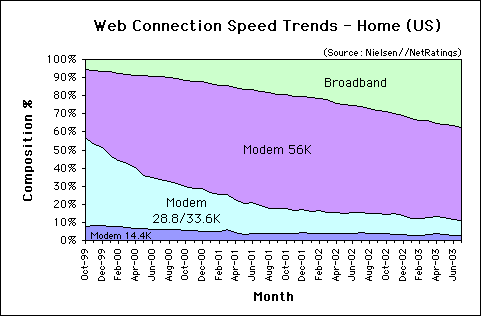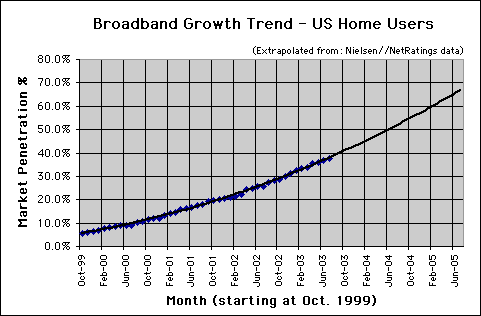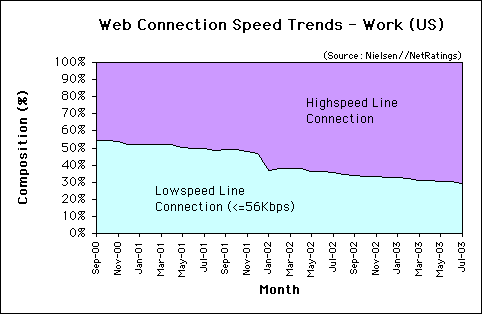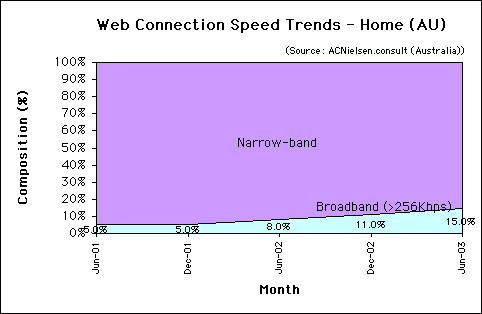Over 15% of wired Australians have a broadband connection, according to a June 2003 ACNielsen.consult survey. 8.3% of New Zealand workers have DSL, according to the ISCR. Overall, broadband grew by 1.1 percentage points in July, with 37.8% of wired US users enjoying a high-speed connection.
The charts and tables below, derived from Nielsen//NetRatings and other data, show trends in connection speeds to the Internet in the US, Australia, and New Zealand.
Home Connectivity in the US
As of July 2003, most users in the US connect to the Internet using dial-up modems of 56Kbps or less. 51% use 56Kbps modems, 8.2% use 28/33.3Kbps, and 3% use 14.4Kbps modems. In total, 62.2% of home users in the US connect to the Internet at 56Kbps or less (see Figure 1).
Web Connection Speed Trends – Home Users (US)
Figure 1: Web Connection Speed Trends – Home Users (US)
Source: Nielsen//NetRatings
Broadband Growth in the US
Broadband penetration in US homes increased by 1.1 percentage points in July. As of July 2003 broadband penetration was at 37.8%, up from 36.7% in June. This is higher than the average increase in broadband of 0.71 percentage points per month from October 1999 to June 2003. Extrapolating the data provided by Nielsen//NetRatings, broadband share in the US should exceed 50% by June of 2004 (see Figure 2).
Broadband Connection Speed Trend – Home Users (US)
Figure 2: Broadband Connection Speed Trend – Home Users (US)
Extrapolated from Nielsen//NetRatings data
Work Connectivity
Most workers in the US enjoy high-speed connections to the Internet. Most use a high-speed line such as a T1 connection, and share bandwidth between computers connected to a network. The speed of each connection decreases as more employees hook up to the LAN. As of July of 2003, of those connected to the Internet, 70.9% of US users at work enjoy a high-speed connection, up 1.1% from 69.8% in June. 29.1% connect from work at 56Kbps or less (see Figure 3).
Web Connection Speed Trends – Work Users (US)
Figure 3: Web Connection Speed Trends – Work Users (US)
Source: Nielsen//NetRatings
Australian Broadband Growth
44.5% of Australian households have an Internet connection, according to a recent survey. Over 15% of wired Australians enjoy a broadband connection at home, according to a June 2003 survey by ACNielsen.consult, Australia (see Figure 4).
Figure 4: Web Connection Speed Trends – Home Users (AU)
Source: ACNielsen.consult (Australia)
New Zealand DSL
Over 60% of New Zealand households have dial-up Internet connections as of March 2003, according to the ISCR. Diffusion of ADSL connections in significant New Zealand businesses is 8.3% as of March 2003. This is among the highest DSL uptake in the OECD. At home, more than 3.2% of New Zealanders have DSL as of April 2003. In comparison, over 7.1% of US households have DSL as of June 2003. For growth curves of the above statistics, see the “Telecommunications Usage” paper below.
References and Further Reading
- ACNielsen.consult (Australia)
- Provided the June 2003 survey statistics for Figure 4 above.
- Australian Competition & Consumer Division
- Shapshot of Broadband Deployment as of 31 March 2003.
- July Bandwidth Report – Cable Trumps DSL, US Broadband Jumps to 36.7%
- Includes DSL statistics for the US.
- ISCR.org.nz
- New Zealand Institute for the Study of Competition and Regulation (see research)
- Telecommunications Usage in New Zealand: 1993-2003 – By Bronwyn Howell and Mark Obren (PDF 1.1MB)
- Building Best Practice Broadband in New Zealand – By Bronwyn Howell, June 2003 (PDF 2MB)
- 2003 NOIE Information Economy Index
- The National Office for the Information Economy (NOIE) Index benchmarks Australia and 11 other countries on their progress in the information economy, ranking countries across 23 statistical indicators, including broadband adoption.
- Organisation for Economic Co-operation and Development
- Has 30 member nations.
The Bandwidth Report is featured monthly on URLwire – news of useful and unique web content since 1994.




